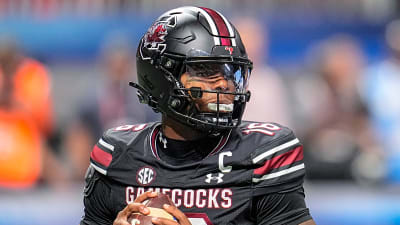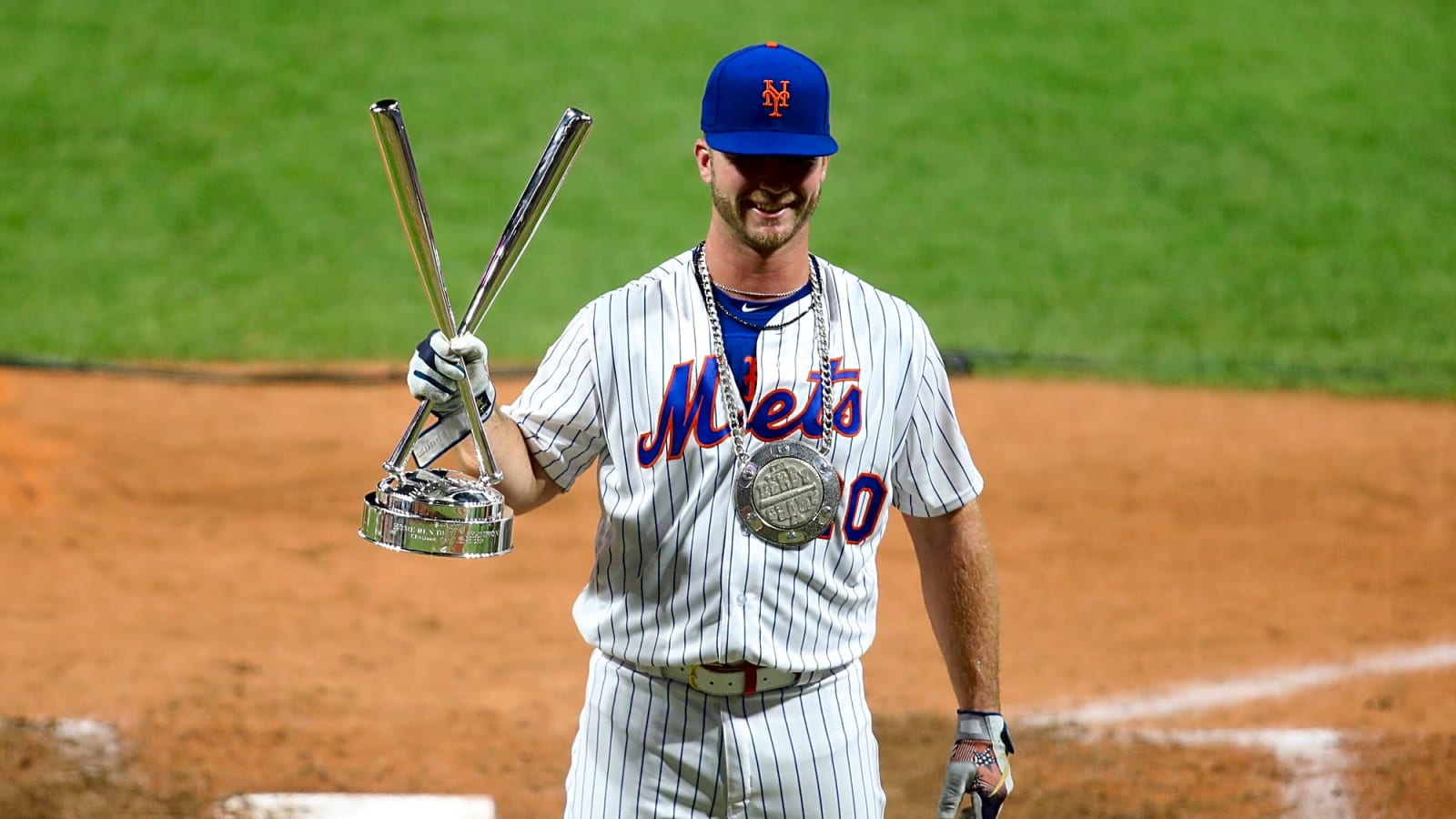
The 2025 MLB Home Run Derby will be held on Monday, July 14th at 8 PM EST.
2024 Home Run Derby champ Teoscar Hernandez will not be defending his title, but the 2025 Home Run Derby field is as stacked as ever. The derby will feature MLB’s home run leader, Cal Raleigh, who is the favorite to win the event along with Oneil Cruz.
The field has combined for 174 home runs this season, which is well above the 2024 group’s total of 147 home runs going into the event.
Before we dive into the analysis, let’s first cover the competition rules, which have changed slightly over the years.
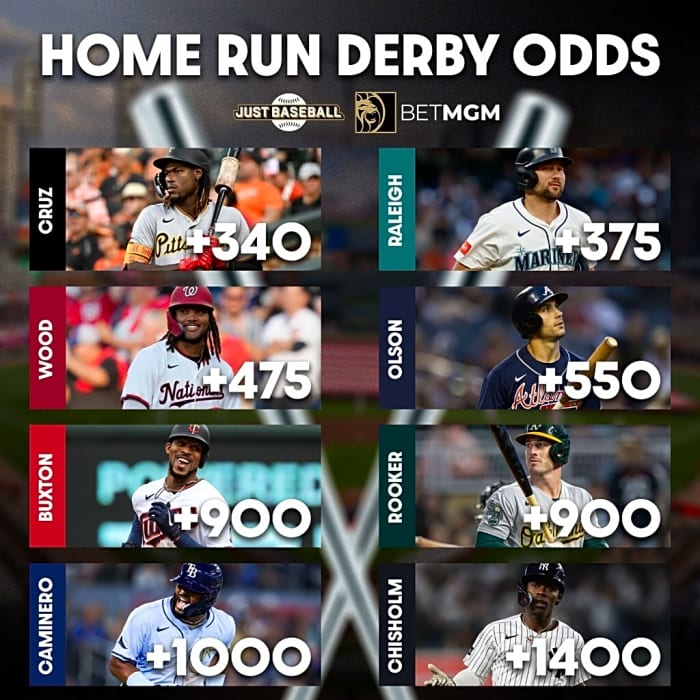
Home Run Derby Rules
In 2015, the rules changed from an “outs” based game to one with a clock. This changed the dynamic of the competition, as now it’s more of a battle of stamina.
This year’s first round will have no predetermined seeds. All eight hitters compete, and the top four home run totals will move on to the next round. If there is a tie after the first round, the tiebreaker will be who had the longest home run hit in that round. Byron Buxton hit a ball 479 feet and owns the farthest home run of the bunch.
In round 1, each batter will have three minutes or 40 pitches, whichever comes first, to his as many home runs as possible. There is also a bonus period for each player that lasts for three outs (any non-home run swing). If a player hits a home run of at least 425 feet within the bonus period, the period is extended until the player records a fourth out.
In the semifinals, the format shifts to “knockout style,” with No. 1 vs. No. 4 and No. 2 vs. No. 3, with seeds determined by first-round home run total. Players will have two minutes or 27 pitches in the semifinals and finals, and home run totals from the first round don’t carry over.
Ties in the semifinals or finals are broken by a 60-second “swing-off” with no additional time added. If a tie remains after the “swing-off,” batters then engage in successive three-swing “swing-offs” until there is a winner.
This year, there is a new wrinkle to the clock. There is a maximum number of pitches each hitter can see in each round. The first round and semifinals will end when three minutes, or 40 pitches, are up. In the finals, it will end whenever two minutes, or 27 pitches, come first, excluding the bonus period.
Additionally, each hitter can take a 45-second timeout during each round.
Past Winners
Every home run derby winner since 2016 has displayed two traits: A max exit velocity over 114 MPH, and an age under 26 years old. We are looking for players with stamina who hit the ball with authority and consistently swing hard.
Players who can hit the ball as hard as possible will be able to hit the ball further, leading to more home runs. The rapid-fire nature of the competition also adds an element of stamina, so you’ll see a trend of younger players winning the derby in recent years. We now have access to swing speed data, which also lends itself to hitting the ball further, so I’ll include that data in the analysis below as well.
Max Exit Velocity
As exit velocity increases, potential home run distance also increases, which gives hitters a better chance to hit home runs even on slight mis-hits. Below are the winners of the HR Derby since 2015 and their max exit velocity from that season.
| Home Run Derby Champions | Max Exit Velo (MPH) |
| Teoscar Hernandez 2024 | 114.1 |
| Vlad Guerrero Jr. 2023 | 116.7 |
| Juan Soto 2022 | 116.6 |
| Pete Alonso 2021 | 118.4 |
| Pete Alonso 2019 | 118.4 |
| Bryce Harper 2018 | 116.3 |
| Aaron Judge 2017 | 121.1 |
| Giancarlo Stanton 2016 | 120.1 |
There has not been a Home Run Derby winner since 2016 with a max exit velocity below 116 MPH. Even second-place finishers Bobby Witt Jr., Randy Arozarena, Julio Rodriguez, Joc Pederson, Miguel Sano, Kyle Schwarber, Vlad Guerrero Jr., and Trey Mancini all had max exit velocities over 114 MPH. It’s simple: the contestants who hit the ball have the best chance at winning.
Age is not just a number.
Adding a time limit instead of the traditional outs system increased the pace of the Home Run Derby. Players have three minutes with one timeout throughout the round, which creates a rapid-fire scenario. It’s easy to get burnt out in the first and second rounds and run out of gas to finish strong and win. It is hard to quantify stamina, but the basic assumption is that the younger players have fresher bodies and longer stamina.
Teoscar Hernandez was the exception to the rule last year as he took home the hardware at 31 years old. Since 2016, every Home Run Derby winner except Teoscar Hernandez has been 26 years old or younger. We still believe it’s a young man’s game.
| Home Run Derby Champions | Age |
| Teoscar Hernandez | 31 |
| Vlad Guerrero Jr. 2023 | 24 |
| Juan Soto 2022 | 23 |
| Pete Alonso 2021 | 26 |
| Pete Alonso 2019 | 24 |
| Bryce Harper 2018 | 25 |
| Aaron Judge 2017 | 25 |
| Giancarlo Stanton 2016 | 26 |
Analyzing Swing Speed Data
Baseball Savant released bat tracking data to the public dating back to 2023. We now have access to average and max swing speeds for all of the 2025 Home Run Derby contestants. The current home run derby format is about getting your best swing off as often as possible and hitting home runs on imperfect contact.
The ability to hit the ball further on imperfect contact increases as swing speed increases. I also want to focus on players who are consistently getting their best swings off to maximize the 2-3 minutes they’ll have in each round. The section below analyzing each 2025 contestant will display average swing speed on competitive swings for this reason.
Picking the 2025 Home Run Derby Winner
Here are the betting odds for each participant from BetMGM with their max exit velocity, average swing speed, and age.
| 2025 HR Derby Players | Betting Odds (BetMGM) | Max Exit Velo | Average Swing Speed | Age |
| Oneil Cruz | +310 | 122.9 MPH | 78.6 MPH | 26 |
| Cal Raleigh | +360 | 114.7 MPH | 75.1 MPH | 28 |
| James Wood | +475 | 117.9 MPH | 76.1 MPH | 22 |
| Matt Olson | +550 | 113.8 MPH | 73.7 MPH | 31 |
| Byron Buxton | +900 | 111.3 MPH | 75 MPH | 31 |
| Brent Rooker | +900 | 112.4 MPH | 73.8 MPH | 30 |
| Junior Caminero | +1000 | 116.5 MPH | 78 MPH | 22 |
| Jazz Chisholm Jr. | +1400 | 110.9 MPH | 73.3 MPH | 27 |
Based on the criteria outlined above, three contestants fit the mold based on max exit velocity and age: Oneil Cruz, James Wood, and Junior Caminero. Cal Raleigh fits the mold based on max exit velocity, but is on the lower end of the acceptable range, and being 28 years old puts him just outside the acceptable age range.
We saw Teoscar Hernandez defy the age trend last year, so I’m not counting Raleigh out, but at +360, there are better options at better prices.
What stands out most is that Oneil Cruz was built in a lab to compete in the home run derby. He has recorded the two hardest hit balls in the Statcast era, and likely ever. He has the highest average swing speed and highest max swing speed, and at age 26, he’s in his prime to win a competition of this nature. There is a reason Cruz is a co-favorite to win the 2025 Home Run Derby while having only 16 home runs this season.
James Wood and Junior Caminero are the two rising stars competing this year, and both have a chance to make noise at the young age of 22.
I will be staying away from Brent Rooker, Byron Buxton, Matt Olson, and Jazz Chisholm Jr. due to age and max exit velocity concerns, especially when each is being valued higher than Junior Caminero, who has better metrics across the board.
Colby Olson’s Official Home Run Derby Pick
Junior Caminero is the best value play on the board. James Wood and Oneil Cruz have a good chance to win this competition based on the analysis above. Still, I will be investing in a player that has similar metrics at a much better price, especially in a competition that has plenty of variance.
Caminero also enters the 2025 Home Run Derby as one of the hottest hitters in the league. He has 13 home runs in his last 40 games, and only players with more home runs over that span are Cal Raleigh, Aaron Judge, Eugenio Suarez, and Juan Soto.
Caminero should be priced just below James Wood and Matt Olson, and I make a fair price on Caminero at +600 to win this competition. There is a ton of value at +1000 or better on BetMGM.
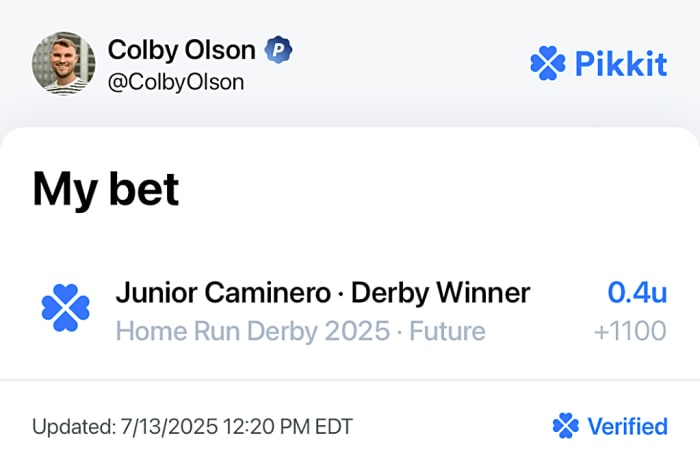
Peter Appel’s Official Home Run Derby Pick
As stated earlier, Oneil Cruz was built in a lab for a competition like this. It’s not often we can bet on a player who fits the trends perfectly and isn’t the clear favorite. I believe Cruz should be priced closer to +200 and should be the clear favorite—risk 0.5 units on Oneil Cruz.
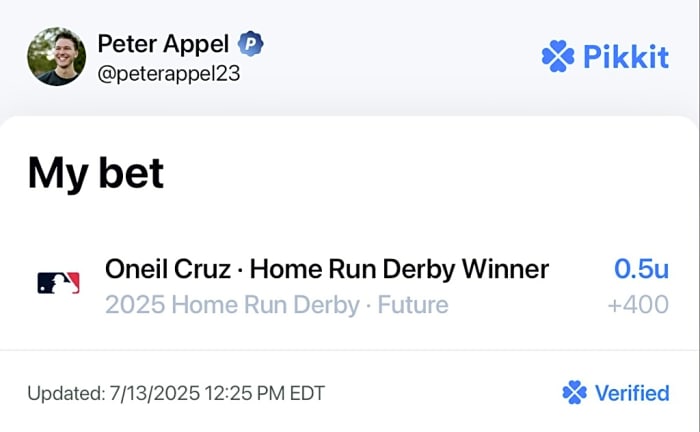
I love Cal Raleigh, but James Wood should be the second favorite here based on the trends. He’s very similar to Oneil Cruz, just a bit behind. I think his odds should be closer to +300, so at this price, I want some action on him—risk 0.25 Units on James Wood.
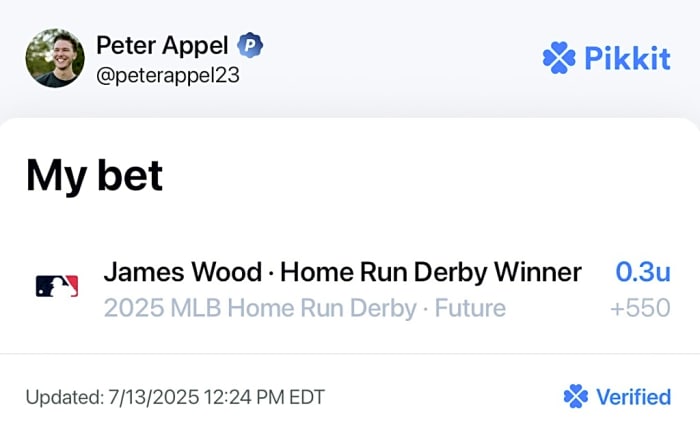
Last but certainly not least is Junior Caminero. He’s the best value play on the board, as he should be closer to the top of the odds rather than at the bottom. The 21-year-old from Tampa is understandably underrated in a competition like this. Not many people have watched him hit, but they’ll learn soon enough—risk 0.15 Units on Junior Caminero.
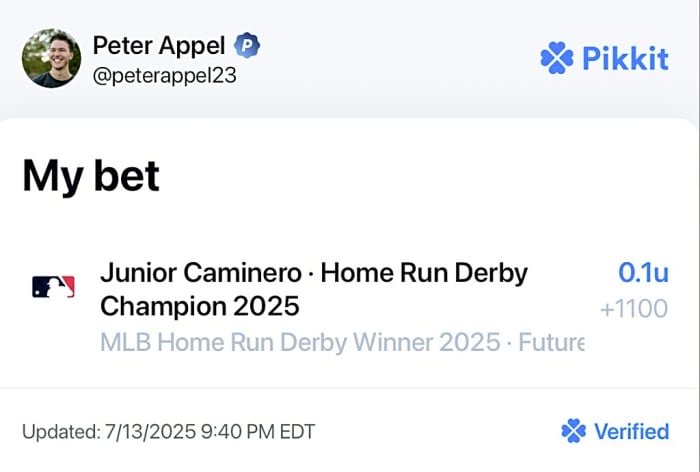
This is the first derby I’ve ever had multiple picks. Typically, I’ll put all of my eggs in one basket, but with the way the odds are stacked up, we have the opportunity to profit if any of these three picks win. I feel pretty confident one of these three will hoist the trophy, but Oneil Cruz has to be my largest wager.
More must-reads:
- World Series Game 1 takeaways: Big inning pushes Blue Jays past Dodgers
- Blue Jays' Addison Barger accomplishes World Series first in Game 1
- The 'World Series home run leaders' quiz
Breaking News
Trending News
Customize Your Newsletter
 +
+
Get the latest news and rumors, customized to your favorite sports and teams. Emailed daily. Always free!



